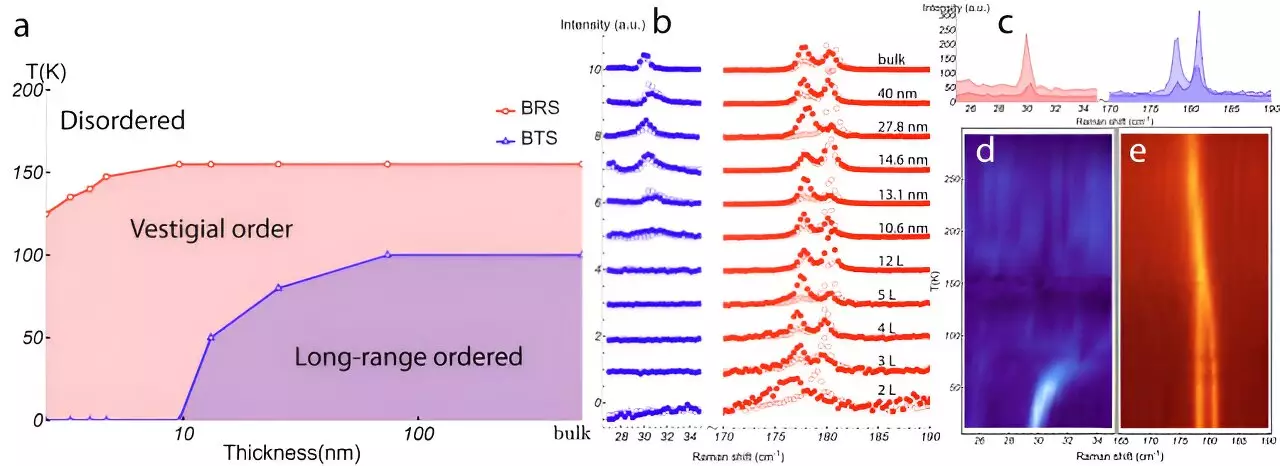The domain of condensed matter physics has witnessed remarkable progress with the advent of van der Waals (vdW) materials, which have unique electronic and magnetic properties beneficial for advancing technology in fields such as electronics, energy storage, and computing. A groundbreaking study conducted by a collaborative group from The University of Hong Kong, Texas Tech University, and the University of Michigan delves into the complexities of nickel phosphorus trisulfide (NiPS3), specifically focusing on the transition between different magnetic states as the material is thinned. This discovery demonstrates a unique transition from a three-dimensional (3D) long-range ordered state to a two-dimensional (2D) vestigial order, offering significant implications for future electronic devices.
NiPS3 stands out among vdW materials due to its layered structure, which can be manipulated to explore its properties at various thicknesses. Researchers began their investigation through the lens of Richard Feynman’s philosophical discourse, “Plenty of Room at the Bottom,” challenging the scientific community to think about the potential of manipulating materials at a nanoscopic level—a vision remarkably realized in current research on NiPS3. By focusing on its magnetic behavior as it transitions to fewer layers, scientists have tapped into a profound exploration of material properties, unveiling an important area of phase transition characterized by symmetry breaking.
In this study, a critical observation was the intermediate phase defined as vestigial order—where some symmetries remain intact despite the loss of the primary long-range order. This is a fascinating deviation from classical symmetry breaking, highlighting a more nuanced understanding of the material’s behavior in lower dimensions. The exploration of this phenomenon emphasizes how modifying the dimensionality of materials can yield intriguing new states of matter.
To achieve their findings, the research team employed innovative methodologies such as nitrogen-vacancy (NV) spin relaxometry and optical Raman quasi-elastic scattering. These sophisticated techniques allowed for the precise characterization of how the magnetic properties of NiPS3 evolve as it transitions from a 3D to a 2D structure. The research team not only tracked the properties observed in the transition but also implemented large-scale Monte Carlo simulations to provide further clarity on the behavior of bilayer NiPS3.
This pioneering work is noteworthy as it rigorously defines the crossover between different magnetic symmetries and phases, unearthing a new understanding of vestigial order observed in a 2D magnetic material. This substantial achievement contributes to a more profound comprehension of phase transitions and behavioral contrasts between two-dimensional and three-dimensional spaces.
The implications of these findings extend far beyond the realm of theoretical physics. The enhanced understanding of material transitions and properties at reduced dimensions opens up an array of potential applications in electronics. For instance, the evolving landscape of electronic devices could harness materials like NiPS3 for high-density storage solutions, ultrafast computing, and energy-efficient systems that utilize layered structures.
Taking a cue from Feynman’s visionary words, the present research brings us closer to realizing a future where materials can be engineered to specific properties at micro- and nano-scales. The layering capabilities of vdW materials potentially lead to the development of flexible and transparent electronics, thus enabling a new wave of planar electronic devices that boast high performance while consuming significantly less energy.
This significant discovery regarding the magnetic properties of NiPS3 signifies a leap in our understanding of condensed matter physics. By examining the transitions and behaviors of materials at varying thicknesses, researchers contribute to the realization of Feynman’s long-pondered question of harnessing materials with established layered structures. As we continue to explore the dimensions of vdW materials and their applications in electronics, the one step achieved towards refining technology heralds great promise for the future—bringing us closer to a world where materials are meticulously engineered to meet the complex demands of modern applications.
This analysis of the intricacies involved in the layered magnetic materials sets a foundation for innovative research endeavors, promising a technological revolution powered by scientific discovery. As the boundaries of material science expand, we can anticipate an era defined by energy-efficient, high-density, and adaptable electronic landscapes.

